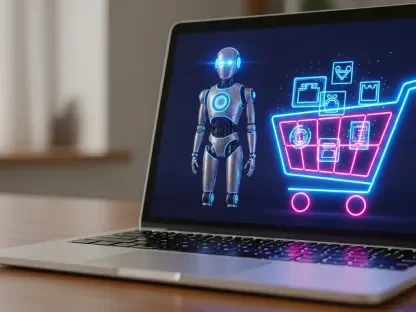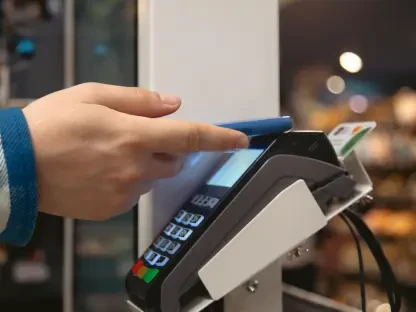Setting the Stage for a Retail Revolution
In the fast-evolving retail landscape of 2025, a staggering $900 billion worth of goods are expected to be returned by U.S. consumers annually, representing nearly 17% of total retail purchases, painting a vivid picture of an industry grappling with the sheer volume of returns. This challenge has grown exponentially with the rise of e-commerce. Retailers, both online and in physical stores, face mounting pressure to manage these returns efficiently while meeting consumer demands for seamless experiences. Reverse logistics, the process of handling returned goods, has emerged as a critical battleground for optimizing delivery systems and preserving profit margins. This report dives into how this often-overlooked aspect of retail is transforming into a strategic asset, driven by technology and shifting market dynamics.
The current state of the industry reveals a dual reality: returns are both a burden and an opportunity. On one hand, high return rates drain resources through operational costs and lost sales potential. On the other, they offer a chance to build customer loyalty through streamlined processes and innovative solutions. As economic pressures like rising labor costs and fluctuating tariffs persist, retailers are compelled to rethink traditional approaches. The integration of automation and smart technologies signals a turning point, positioning reverse logistics as a cornerstone of modern delivery optimization. This analysis explores the trends, challenges, and future prospects shaping this vital sector.
Understanding Reverse Logistics in Modern Retail
Reverse logistics refers to the management of goods returned by customers, encompassing everything from processing refunds to restocking or disposing of items. Historically, this function was seen as a necessary evil, a cost center that drained resources without adding value. Retailers often approached returns with minimal investment, focusing instead on forward logistics and sales growth. However, the surge in e-commerce, coupled with heightened consumer expectations for hassle-free returns, has shifted this perception. Today, effective management of returns is recognized as essential for maintaining competitiveness in both online marketplaces and traditional brick-and-mortar stores.
The growing importance of reverse logistics is evident across key industry segments. In e-commerce, where return rates can exceed 20% for categories like apparel, companies are prioritizing efficient systems to handle high volumes. Major players such as Amazon and Walmart have adopted innovative solutions, including automated return centers and partnerships with third-party logistics providers. Meanwhile, physical retailers are leveraging in-store return processes to enhance customer experiences. The adoption of technologies like smart parcel lockers, which allow customers to drop off returns securely and conveniently, is gaining traction as a way to reduce costs and improve satisfaction.
This transformation is fueled by broader market forces. Rising return rates, driven by practices like “bracketing”—where consumers order multiple sizes or styles with the intent to return some—have forced retailers to rethink their strategies. Additionally, consumer expectations for quick refunds and easy processes have become non-negotiable. As a result, reverse logistics is no longer just about damage control; it is a critical component of delivery optimization, influencing everything from inventory management to brand reputation.
Trends and Market Dynamics in Reverse Logistics
Key Trends Shaping the Returns Landscape
One of the most defining trends in reverse logistics is the persistent increase in return rates, with an estimated 17% of U.S. retail purchases returned in the current year. This spike is particularly pronounced in online retail, where the inability to physically inspect products drives higher return volumes. Consumers now expect not only free returns but also instantaneous processing, pushing retailers to invest in systems that can meet these demands. The pressure to deliver seamless experiences has turned returns into a key differentiator, with many customers basing their loyalty on the ease of the process.
Economic factors are also reshaping the returns landscape. Retailers face challenges from fluctuating tariffs and escalating labor costs, which squeeze margins and necessitate cost-effective solutions. Automation technologies, such as smart parcel lockers, are emerging as game-changers by minimizing manual intervention and reducing operational expenses. These tools also contribute to sustainability goals by consolidating drop-offs, thereby cutting down on transportation emissions. The alignment of efficiency and environmental responsibility is becoming a significant driver for technology adoption in this space.
Another trend is the evolving role of data in returns management. Retailers are increasingly using analytics to predict return patterns and optimize processes. For instance, algorithms can identify high-return products and adjust inventory or marketing strategies accordingly. This data-driven approach, combined with automation, enhances the speed of refund processing and resale, turning returns into a less disruptive part of the supply chain. As these trends converge, reverse logistics is being repositioned as a strategic asset rather than a liability.
Market Insights and Growth Projections
The scale of reverse logistics is staggering, with returns in the U.S. alone valued at approximately $900 billion annually as of now. This figure is expected to grow in tandem with e-commerce expansion, which continues to outpace traditional retail channels. Projections suggest that by 2027, the value of returns could approach $1.1 trillion if current growth rates persist. This trajectory underscores the urgent need for scalable solutions that can handle increasing volumes without compromising profitability or customer satisfaction.
Performance indicators provide further insight into the state of the market. Refund processing speed, a critical metric for customer experience, has improved with automation, with some retailers achieving same-day refunds through integrated systems. Resale rates for returned goods are also on the rise, as companies prioritize quick restocking of items in sellable condition. These metrics highlight the tangible benefits of investing in reverse logistics infrastructure, from protecting revenue to enhancing operational agility.
Looking ahead, technology adoption is poised to shape market dynamics significantly. The proliferation of smart locker networks and automated sorting systems is expected to drive efficiency gains over the next few years. Additionally, the integration of artificial intelligence for predictive analytics will likely refine inventory management and return forecasting. As these innovations gain traction, the reverse logistics market is set to evolve into a more streamlined and value-driven segment of the retail ecosystem.
Challenges in Optimizing Reverse Logistics
Managing returns effectively remains a complex endeavor for retailers, primarily due to the high operational costs involved. Processing returns often requires significant resources, including transportation, warehousing, and staff time to inspect and restock items. These expenses can erode profit margins, especially for smaller businesses that lack the scale to absorb such costs. Finding ways to minimize these financial burdens without compromising service quality is a persistent hurdle.
Labor-intensive processes add another layer of difficulty. Returns often involve manual tasks such as verifying product condition, updating inventory records, and handling customer inquiries. These activities not only tie up valuable staff time but also increase the risk of errors, further complicating operations. Automation offers a potential solution by reducing reliance on human intervention, but the upfront investment in such technology can be prohibitive for some retailers, creating a barrier to optimization.
Inventory management complexities and customer dissatisfaction also pose significant challenges. Returned goods often linger in limbo, delaying restocking or resale and tying up capital. At the same time, cumbersome return policies can frustrate consumers, leading to negative perceptions of a brand. Addressing these issues requires a balanced approach, integrating user-friendly policies with efficient backend systems. Strategic partnerships with logistics providers and investments in scalable technologies are essential steps toward overcoming these obstacles.
Regulatory and Compliance Considerations in Reverse Logistics
The regulatory landscape surrounding reverse logistics is multifaceted, impacting how retailers manage returns on several fronts. Consumer protection laws, for instance, mandate clear return policies and timely refunds, ensuring that customers are not disadvantaged by the process. Compliance with these regulations is critical to avoid legal repercussions and maintain trust, particularly in markets with stringent standards. Retailers must stay abreast of evolving rules to align their practices accordingly.
Environmental regulations also play a significant role, especially concerning packaging waste and disposal of unsellable goods. Many jurisdictions now require businesses to minimize their ecological footprint, pushing retailers to adopt sustainable practices in returns management. This includes reducing single-use packaging and ensuring proper recycling or disposal of damaged items. Smart parcel lockers contribute to these efforts by consolidating returns and reducing unnecessary trips, aligning with regulatory goals for sustainability.
Data security is another crucial compliance area, particularly with the rise of automated systems. Smart lockers and online return platforms often handle sensitive customer information, necessitating robust safeguards against breaches. Retailers must adhere to data protection standards to prevent unauthorized access and ensure consumer confidence. As regulatory frameworks continue to evolve, staying compliant while innovating in reverse logistics remains a delicate balance for the industry, influencing strategic decisions at every level.
The Future of Reverse Logistics and Delivery Optimization
Emerging technologies are set to redefine the trajectory of reverse logistics, offering new avenues for efficiency and customer engagement. Data-driven SKU routing, for instance, enables retailers to direct returned items to the most appropriate destination based on condition or demand, minimizing handling time. Smart locker networks are expanding as well, providing scalable solutions for convenient drop-offs while reducing operational strain. These advancements signal a shift toward precision and automation in returns management.
Consumer preferences are also evolving, with a growing emphasis on convenience and sustainability. Shoppers increasingly value return processes that are quick and accessible, often favoring brands that offer flexible options like locker drop-offs over traditional methods. Simultaneously, there is a rising demand for eco-friendly practices, pushing retailers to adopt solutions that lower carbon footprints. Aligning reverse logistics with these priorities will be essential for maintaining relevance in a competitive market.
Potential disruptors, such as novel automation tools and global economic conditions, could further shape the future. Innovations like robotic sorting systems may streamline processing at scale, while economic factors like trade policies could impact cost structures. Retailers must remain agile, adapting to these changes through continuous investment in technology and strategic planning. The intersection of innovation and market dynamics will likely define growth areas, positioning reverse logistics as a key pillar of delivery optimization in the years ahead.
Reflecting on Insights and Charting the Path Forward
Looking back, this exploration of reverse logistics reveals a profound shift in how returns are perceived and managed within the retail sector. What was once dismissed as a mere operational cost is now recognized as a vital opportunity to enhance efficiency and foster customer loyalty. The analysis underscores the transformative impact of technologies like smart parcel lockers, which streamline processes and address pressing challenges. Market trends and regulatory considerations further highlight the complexity and urgency of optimizing this space.
Moving forward, retailers are encouraged to take decisive action by investing in automation and data-driven solutions to stay competitive. Prioritizing strategic locker placement and integrating advanced routing systems emerge as practical steps to boost operational agility. Additionally, aligning returns management with sustainability goals offers a way to meet consumer expectations and comply with environmental standards. By embracing these initiatives, businesses can transform reverse logistics into a lasting competitive advantage.
The journey ahead demands a proactive mindset, with an emphasis on continuous adaptation to technological and market shifts. Retailers are urged to explore partnerships with logistics innovators to scale their capabilities. Building resilience through such strategies ensures they are well-equipped to navigate future uncertainties. Ultimately, the commitment to reimagining returns as a value driver paves the way for sustained growth and customer-centric success in an ever-changing industry.









